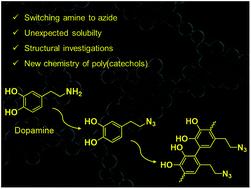当前位置:
X-MOL 学术
›
Polym. Chem.
›
论文详情
Our official English website, www.x-mol.net, welcomes your feedback! (Note: you will need to create a separate account there.)
Replacing amine by azide: dopamine azide polymerization triggered by sodium periodate
Polymer Chemistry ( IF 4.1 ) Pub Date : 2022-05-09 , DOI: 10.1039/d2py00293k Monika Szukowska 1, 2 , Łukasz Popenda 3 , Emerson Coy 3 , Claudiu Filip 4 , Jakub Grajewski 1 , Mateusz Kempiński 5 , Yeonho Kim 6 , Radosław Mrówczyński 1, 2
Polymer Chemistry ( IF 4.1 ) Pub Date : 2022-05-09 , DOI: 10.1039/d2py00293k Monika Szukowska 1, 2 , Łukasz Popenda 3 , Emerson Coy 3 , Claudiu Filip 4 , Jakub Grajewski 1 , Mateusz Kempiński 5 , Yeonho Kim 6 , Radosław Mrówczyński 1, 2
Affiliation

|
Polydopamine (PDA) has been widely described for a range of biomedical and surface engineering applications. However the structure of PDA remains elusive owing to the insoluble nature of the polymer. Furthermore, the influence of the amine group present in the polydopamine and related functional polycatchols on the character and the structure of resulting functional materials remains vague. Here we perform polymerization of the dopamine analogue 4-(2-azidoethyl)benzene-1,2-diol (dopamine azide), where the amine group is switched to azide, using sodium periodate, which gives rise to particles with a diameter of up to one micrometer. The obtained particles are stable in water but, in contrast to other polycatcechol-based polymers, are soluble in organic solvents. The detailed structural investigations using various liquid and solid-state nuclear magnetic resonance (NMR) spectroscopy methods, X-ray photoelectron spectroscopy (XPS) and mass spectrometry (ESI/MALD) prove that the obtained polymeric material consists mainly of repeating monomers linked by C–C bonds of aromatic units bearing open-azidoethyl chains. Moreover, the resulting polymer shows a different morphology from polydopamine (PDA) obtained under the same polymerization conditions. Therefore, our results are an important step towards understanding the relationships between the structures of the starting catechol monomers and shed new light on the influence of the amine group on the nature of the resulting poly(catechols).
中文翻译:

叠氮化物代替胺:高碘酸钠引发多巴胺叠氮化物聚合
聚多巴胺 (PDA) 已被广泛用于一系列生物医学和表面工程应用。然而,由于聚合物的不溶性,PDA 的结构仍然难以捉摸。此外,聚多巴胺和相关功能性聚儿茶酚中存在的胺基对所得功能性材料的特性和结构的影响仍然模糊不清。在这里,我们使用高碘酸钠对多巴胺类似物 4-(2-azidoethyl)benzo-1,2-diol (dopamine azide) 进行聚合,其中胺基转变为叠氮化物,从而产生直径为到一微米。获得的颗粒在水中是稳定的,但与其他聚儿茶酚基聚合物相比,它可溶于有机溶剂。使用各种液态和固态核磁共振 (NMR) 光谱方法、X 射线光电子能谱 (XPS) 和质谱 (ESI/MALD) 进行的详细结构研究证明,所得聚合物材料主要由通过 C 连接的重复单体组成带有开叠氮乙基链的芳族单元的 -C 键。此外,所得聚合物显示出与在相同聚合条件下获得的聚多巴胺 (PDA) 不同的形态。因此,我们的结果是了解起始儿茶酚单体结构之间关系的重要一步,并为胺基对所得聚(儿茶酚)性质的影响提供了新的启示。X 射线光电子能谱 (XPS) 和质谱 (ESI/MALD) 证明所获得的聚合物材料主要由带有开环叠氮乙基链的芳族单元的 C-C 键连接的重复单体组成。此外,所得聚合物显示出与在相同聚合条件下获得的聚多巴胺 (PDA) 不同的形态。因此,我们的结果是了解起始儿茶酚单体结构之间关系的重要一步,并为胺基对所得聚(儿茶酚)性质的影响提供了新的启示。X 射线光电子能谱 (XPS) 和质谱 (ESI/MALD) 证明所获得的聚合物材料主要由带有开环叠氮乙基链的芳族单元的 C-C 键连接的重复单体组成。此外,所得聚合物显示出与在相同聚合条件下获得的聚多巴胺 (PDA) 不同的形态。因此,我们的结果是了解起始儿茶酚单体结构之间关系的重要一步,并为胺基对所得聚(儿茶酚)性质的影响提供了新的启示。所得聚合物显示出与在相同聚合条件下获得的聚多巴胺 (PDA) 不同的形态。因此,我们的结果是了解起始儿茶酚单体结构之间关系的重要一步,并为胺基对所得聚(儿茶酚)性质的影响提供了新的启示。所得聚合物显示出与在相同聚合条件下获得的聚多巴胺 (PDA) 不同的形态。因此,我们的结果是了解起始儿茶酚单体结构之间关系的重要一步,并为胺基对所得聚(儿茶酚)性质的影响提供了新的启示。
更新日期:2022-05-09
中文翻译:

叠氮化物代替胺:高碘酸钠引发多巴胺叠氮化物聚合
聚多巴胺 (PDA) 已被广泛用于一系列生物医学和表面工程应用。然而,由于聚合物的不溶性,PDA 的结构仍然难以捉摸。此外,聚多巴胺和相关功能性聚儿茶酚中存在的胺基对所得功能性材料的特性和结构的影响仍然模糊不清。在这里,我们使用高碘酸钠对多巴胺类似物 4-(2-azidoethyl)benzo-1,2-diol (dopamine azide) 进行聚合,其中胺基转变为叠氮化物,从而产生直径为到一微米。获得的颗粒在水中是稳定的,但与其他聚儿茶酚基聚合物相比,它可溶于有机溶剂。使用各种液态和固态核磁共振 (NMR) 光谱方法、X 射线光电子能谱 (XPS) 和质谱 (ESI/MALD) 进行的详细结构研究证明,所得聚合物材料主要由通过 C 连接的重复单体组成带有开叠氮乙基链的芳族单元的 -C 键。此外,所得聚合物显示出与在相同聚合条件下获得的聚多巴胺 (PDA) 不同的形态。因此,我们的结果是了解起始儿茶酚单体结构之间关系的重要一步,并为胺基对所得聚(儿茶酚)性质的影响提供了新的启示。X 射线光电子能谱 (XPS) 和质谱 (ESI/MALD) 证明所获得的聚合物材料主要由带有开环叠氮乙基链的芳族单元的 C-C 键连接的重复单体组成。此外,所得聚合物显示出与在相同聚合条件下获得的聚多巴胺 (PDA) 不同的形态。因此,我们的结果是了解起始儿茶酚单体结构之间关系的重要一步,并为胺基对所得聚(儿茶酚)性质的影响提供了新的启示。X 射线光电子能谱 (XPS) 和质谱 (ESI/MALD) 证明所获得的聚合物材料主要由带有开环叠氮乙基链的芳族单元的 C-C 键连接的重复单体组成。此外,所得聚合物显示出与在相同聚合条件下获得的聚多巴胺 (PDA) 不同的形态。因此,我们的结果是了解起始儿茶酚单体结构之间关系的重要一步,并为胺基对所得聚(儿茶酚)性质的影响提供了新的启示。所得聚合物显示出与在相同聚合条件下获得的聚多巴胺 (PDA) 不同的形态。因此,我们的结果是了解起始儿茶酚单体结构之间关系的重要一步,并为胺基对所得聚(儿茶酚)性质的影响提供了新的启示。所得聚合物显示出与在相同聚合条件下获得的聚多巴胺 (PDA) 不同的形态。因此,我们的结果是了解起始儿茶酚单体结构之间关系的重要一步,并为胺基对所得聚(儿茶酚)性质的影响提供了新的启示。















































 京公网安备 11010802027423号
京公网安备 11010802027423号